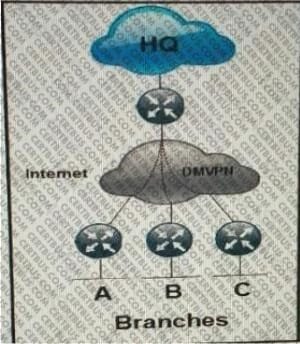Exam Details
Exam Code
:352-001Exam Name
:CCDE WrittenCertification
:Cisco CertificationsVendor
:CiscoTotal Questions
:705 Q&AsLast Updated
:Jul 03, 2023
Cisco Cisco Certifications 352-001 Questions & Answers
-
Question 181:
Refer to the exhibit.

Which routing solution is the most scalable to connect the branches to the HQ and to connect the branches together over the internet using DMVPN?
A. EIGRP
B. EIGRP with the branch routers setup as stubs
C. OSPF with each branch router as an ABR
D. IS-IS L2 in all locations
E. OSPF Area 0 in all locations
-
Question 182:
What is a design application of control plane policing?
A. CPP protects the control plane from reconnaissance and or denial-of-service attacks
B. CPP protects the forwarding plane by rate 璴imiting excessive routing protocol traffic
C. CPP protects the forwarding plane by allowing legitimate traffic and dropping excessive traffic
D. CPP drop malformed packet that are sent to the CPU
-
Question 183:
A large enterprise network running IS-IS wants to deploy IGP traffic engineering, but they are concerned that the IS-IS default metrics are not flexible enough. Which feature must be enabled to provide traffic engineering with the minimum amount of changes?
A. IS-IS Narrow Metrics
B. IS-IS DIS
C. IS-IS Wide Metrics
D. IS-IS Multitopology
-
Question 184:
An enterprise customer A with provider-independent address space is dual-homed to two ISP.
Which two options , when combined, allow for customer A to efficiently achieve out-bond traffic load-balancing? ( Choose two)
A. Advertise Customer A subnets with a shorter AS path prepend to one of the ISPs than to the other
B. Advertise Customer A subnets with different MED values to the two ISPs
C. Accept a default route from both ISPs
D. Make the CE connected to both ISPs route reflector
E. Accept the routes originated on both ISPs and their direct peers
-
Question 185:
What is a design benefit of PortFast?
A. PortFast allows small, unmanaged switches to be plugged into ports of access switches without risking switch loops
B. PortFast disables spanning-tree on the port, which puts the port into the forwarding state immediately after it is connected
C. Portfast does not generate a spanning-tree topology change when a station on a port is connected or disconnected
D. PortFast detects one-way communications on the physical port, when prevents switch loops
E. PortFast prevents switched traffic from traversing suboptimal paths on the network
F. PortFast prevents switch loops that are caused by a unidirectional point-to-point link condition on Rapid PVST+ and MST
-
Question 186:
How can EIGRP topologies be designed to converge as fast as possible in the event of a point-to-point link failure?
A. Build neighbor adjacencies in a triangulated fashion
B. Build neighbor adjacencies in a squared fashion
C. Limit the query domain by use of distribute lists
D. Limit the query domain b use of summarization
E. Limit the query domain by use of default routes
-
Question 187:
A customer has a DMVPN network with EIGRP as the overlay protocol. EIGRP timers cannot be shortened, yet the customer requires the detection of lost connectivity between neighbors in less than three seconds. Which action achieves this requirement?
A. Adjust the GRE keepalive timers
B. Enable BFD
C. Deploy IPsec dead peer detection
D. Adjust the NHRP timers.
-
Question 188:
Which options do you investigate first when designing fast network convergence?
A. Routing protocol database size
B. MTU of the involved interfaces
C. Link speed between sites
D. Supported Layer 3 failure detection mechanism
-
Question 189:
In a design around fast convergence in case of a link failure, what is the justification for using a point-to-point OSPF network type on the Ethernet links between leaf-and-spine switches on a data center fabric?
A. Link failure tears down neighbor relationships regardless of network type configured
B. Type 1 LSAs are not generated on a point-to-point network type
C. Adjacencies can be built faster without a DR/BDR on the segment
D. The fabric memory requirements are significantly smaller than with a DR/BDR on each leaf and spine segment
E. The point-to-point network type allows for NSF to be used in this design
-
Question 190:
How can a network designer reduce the amount of LSA flooding occurring in a large, single area fully-meshed OSPF topology?
A. Implemented passive OSPF interfaces on the routers not participating on the DR/BDR election.
B. Use access control lists to control outbound advertisements.
C. Ensure DR and BDR routers are placed optimally in the topology.
D. Place all point-to-point links in their own dedicated areas.
Related Exams:
300-915
Developing Solutions using Cisco IoT and Edge Platforms (DEVIOT)300-920
Developing Applications for Cisco Webex and Webex Devices (DEVWBX)352-011
Cisco Certified Design Expert Practical500-052
Cisco Unified Contact Center Express500-173
Designing the FlexPod Solution (FPDESIGN)500-174
Implementing and Administering the FlexPod Solution (FPIMPADM)500-201
Deploying Cisco Service Provider Mobile Backhaul Solutions500-210
SP Optical Technology Field Engineer Representative500-220
Cisco Meraki Solutions Specialist500-230
Cisco Service Provider Routing Field Engineer
Tips on How to Prepare for the Exams
Nowadays, the certification exams become more and more important and required by more and more enterprises when applying for a job. But how to prepare for the exam effectively? How to prepare for the exam in a short time with less efforts? How to get a ideal result and how to find the most reliable resources? Here on Vcedump.com, you will find all the answers. Vcedump.com provide not only Cisco exam questions, answers and explanations but also complete assistance on your exam preparation and certification application. If you are confused on your 352-001 exam preparations and Cisco certification application, do not hesitate to visit our Vcedump.com to find your solutions here.